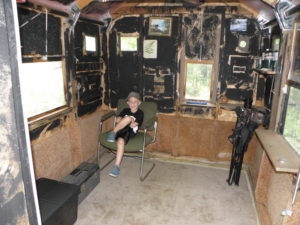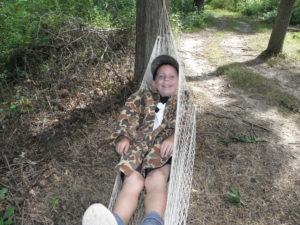By Glen Wunderlich
Landon, my 6 year-old great grandson, has been growing up in Michigan’s suburban Garden City and his connection to the outdoor world has been quite limited. We haven’t seen much of each other over the years – mostly through visits during birthdays or holidays. That was about to change, as he eagerly anticipated a visit to Shiawassee County with yours truly, his “Grandpa.”
As most anyone who’s ever spent any time with a youngster knows, kids are impressionable. On a previous visit, we traveled to the nearby Looking Glass River and discovered a lone whitetail deer along the bank in clear sight; it watched us, as we watched it. Landon never forgot that image and had asked me to take him back there so we could see “the” deer.
He replayed that seemingly insignificant moment, so as part of an extended weekend, we planned a camping trip in the wild. The setting was actually one of my more elaborate hunting shacks that has doubled as a stark 7×8-foot cabin.

Landon in the shack
Nestled in the woods far enough from modern conveniences there would be no TV, video games, telephones, electricity or running water – a radical departure from Landon’s everyday-existence in suburbia.
Sleeping bags, lanterns, a hammock strung between two trees

Hammock Test
, plus a campfire, hotdogs and marshmallows rounded out the scene on a ridge overlooking a swamp. (Fortunately, the extra dry weather has kept the mosquito population in check, so the pestering bugs were not a factor in our adventure.)
Before nightfall, Grandpa had other plans: a coyote hunt at dusk. I was compelled to explain why anyone would want to eliminate coyotes from the gene pool and Landon accepted my rationale. So, off we went about an hour or so before dark to hide and watch – and, to do a bit of varmint calling before nightfall descended.
With plenty of available daylight, several deer appeared in the field we were observing. One velvet-antlered buck and two does were feeding in front of us and provided a better show than can be found via any electrical gadget. When the coyote calling began a bit before dark, the deer certainly took notice. And, Landon observed that the deer were on high alert in search of trouble, although they never spooked. We were not able to get any coyotes to respond, but the show intensified, as the whitetails came closer to us before we headed back to camp.
The nighttime temperature dipped into the 50s but we were comfy within the confines of the shack. A candle lantern burned throughout the darkness and kept the scary factor at bay for the newly initiated outdoorsman.
We laughed and played together for another two days, as I relived my childhood vicariously through the good-natured child. My guess is that we’ll do it again, too.











